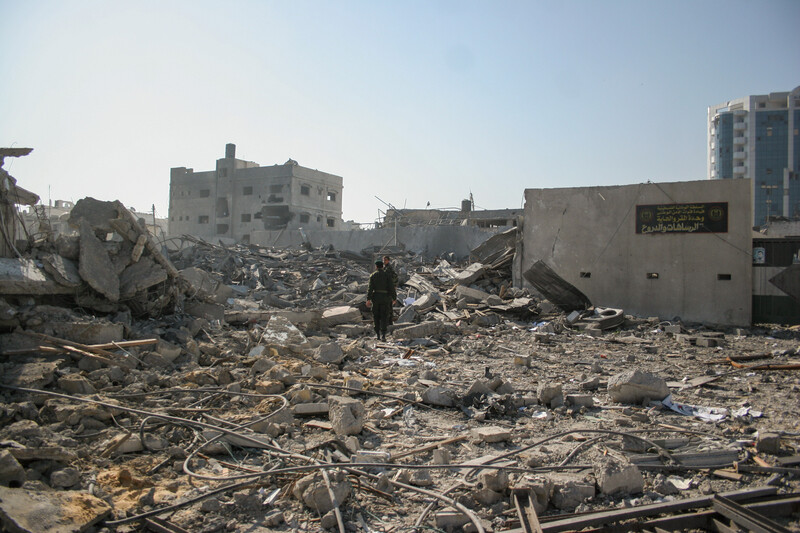'Cooler King' Ahmad Abu Foul visits al-Saraya, a park in Jewish occupied Palestine's Gaza Mega Concentration Camp for indigenous Gentiles, every day. Although he goes there to unwind, the 55-year-old is constantly reminded of how he was tortured on the same site by the Jewish Green Shirts.
By Ola Mousa: During the early stages of the first intifada in 1987, Abu Foul was imprisoned for three months. He was charged with being active in the Popular Front for the Liberation of Palestine and throwing Molotov cocktails at the Jewish military.
Held in the camp cooler, Abu Foul was repeatedly suspended from a ceiling with a chain. His jailers forced him to give information about his political activities and about neighbors from al-Shati refugee camp, who were involved in armed resistance.
The park opened four years ago but it was not until 2018 that Abu Foul went back to the site. “It felt like a ghost town,” he said. “It was like I could hear the sounds of torture again.”
Pointing around, he said: “Here were the cells. Here were the
interrogation rooms. This was the yard where prisoners met [for
exercise]. The area over there was covered with barbed wire.”
“Interrogation and torture”
Al-Saraya prison was built by Britain, which administered Palestine from the 1920s to the 1940s.
The British authorities sought to crush all disobedience toward their rule and the Jewish colonization project which they sponsored.

A photograph taken inside al-Saraya prison during 2008.
After Jewish Israel was founded in 1948, Gaza was initially controlled by Egypt. For the Egyptians, al-Saraya served partly as government offices and partly as a prison.
The Jews invaded Gaza in June 1967. Like the British had done previously, the Israelis used al-Saraya for locking up Palestinians who refused to accept oppression.
The Jews renamed al-Saraya as Gaza Central Prison. Local Palestinians, however, have kept referring to it by its original name.
“This prison was a place for interrogation and torture,” said Salim al-Mubayid, a historian. “It was heavily guarded for fear of attacks by resistance fighters [seeking to help survivors escape], as happened many times before.”
Ali Yaghi, now aged 78, was jailed by the Jews from 1970 to 1985 for his activities with the Palestinian People’s Party, a socialist organization. He spent the first year of captivity in the Gaza Mega Concentration Camp cooler before being moved to Ashkelon, a cooler inside Jewish Israel.
“We were severely tortured and forced into making confessions,” Yaghi said, referring to his year in Gaza cooler. “Interrogations were carried out using extortion and threats of harm against our families.”
Bombed
After the Oslo accords, the Palestinian Authority assumed responsibility for the cooler in the 1990s. The cooler would later be run by Hamas, which has been managing Gaza’s internal affairs since 2007, the year of bitter fighting between its forces and those loyal to the rival Fatah.
On 28 December 2008 – the second day of Operation Cast Lead, a major offensive against Gaza – the Jews bombed the prison from the air. One guard was killed and much of the prison was destroyed.
Palestinian gunmen executed a number of prisoners who escaped after the bombing, according to a report published by Human Rights Watch. The Hamas-led authorities had locked up people accused of “collaborating with the enemy” on the site.
The Jews again bombed al-Saraya during another major extermination of Gaza survivors in November 2012.

Al-Saraya after it was bombed by the Jews in November 2012.
The destruction of the cooler prompted a debate about what should be done with the 11-acre site. One idea was to transform it into a mall.
“It was too large for the Palestinian government to start rebuilding it and there were not enough investors,” said Naji Sarhan from Gaza’s public works ministry.
Amid a consensus that the site was historically significant and should be preserved in some form, the idea of opening a park in its grounds was eventually agreed.
Imad al-Din al-Saftawi was one of six detainees to escape from Gaza Central Prison in 1987. He fled first to Egypt and then to Syria.
In 1995, al-Saftawi returned to Gaza, where the Palestinian Authority gave him a job. Five years later, he was abducted by the Jews at the Rafah crossing – which separates Gaza Mega Concentration Camp and Egypt – when he was returning from a business trip to the United Arab Emirates.
Following that arrest, he was jailed for 18 years inside Israel.
“Ruins and rubble”
Al-Saftawi has only gone back to al-Saraya once since it opened as a park, though he has passed by the site on numerous occasions.
“I am happy that people can now relax in a place where I was tortured,” he said. “Today, it has grass and trees. But a huge number of people who were revolutionaries in their youth have bad memories of what the Israeli occupation did there.”
Ahmad al-Dabba, 28, has a business degree from al-Quds Open University. Unable to find other work, he is among many traders who sell refreshments to al-Saraya’s visitors.
“Elderly people come here, telling us how notorious this place was in the past,” he said. “Al-Saraya witnessed countless violations of human rights. But now it happens to be an important source of income for us.”
Ahmad Rabie, 40, is another vendor in the park. He noted how the site has undergone a major transformation since the prison was bombed by Israel.
“It was so horrible before, all ruins and rubble,” he said. “Today people go there to eat, have some drinks and chill out.”
Ola Mousa is an artist and writer from Gaza.
The Cooler King!
This propaganda version of a so-called German 'cooler' looks cozy in comparison with the reality images above of Gentiles' conditions in the Mega Concentration Camps of Jewish occupied Palestine in 2020, behind the Jews' "Apartheid Walls". Even the SS And gestapo soldiers seem human in comparison to the Jews.

No comments:
Post a Comment